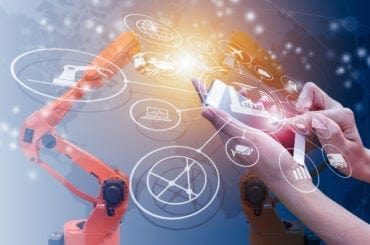
By bringing responsiveness and innovation to where it is needed, intelligent IoT devices are fueling digital transformation.
As organizations move intelligence to the edge, the impact and implications extend well beyond distributing processing workloads closer to the point of origin of data. Now, intelligent endpoint devices and systems have the ability not only to connect with one another, but also to enable rapid experimentation, real-time insights, and align to deliver services on demand for ever-changing business requirements. In short, intelligent Edge Computing and the IoT are the ultimate innovation machine.
Enterprises are just beginning to tap into the power and possibilities that intelligent Edge Computing offers. A recent survey of 700 enterprises by Spiceworks, for example, finds 15 percent currently use Edge Computing, and another 17 percent are in stages of implementation. Edge Computing adoption is projected to grow at a rate close to 20 percent compounded annually from 2018 to 2022, according to Technavio.
As intelligent edge devices take on critical analytics and decision-making tasks, the doors open to innovation and new ways of doing business not previously possible. Enterprises are finally able to achieve a long-sought-after goal: eliminating the barriers that separate their businesses from customers, employees, and partners. Sensors and devices monitoring and managing vehicles, factories, warehouses, city streets, and farms are now forming the new central nervous system of the economy. In turn, these devices are serving to reduce marginal costs for product, service and information delivery to near zero.
Intelligent Edge Computing will deliver business value in the following ways.
- Open up experimentation and innovation: For many organizations, the ability to act on innovation was limited by access to available data and computing resources. Intelligent end devices and open standards-based middleware make it possible to connect to and normalize formerly siloed information. With intelligent processing capabilities distributed across various endpoints, experimentation and innovation can take place close to the source of data, as well as in closer proximity to where innovation is required.
- Build a powerful platform: The key to success and innovation for many enterprises in the digital era is the platform approach – an ongoing process of opening up applications, systems, data and services to partners, communities and other interested parties, via APIs, cloud services, self-service portals, and open data, or other means. With intelligent edge devices, participants in platform networks have access to compute power and insights (and may contribute insights) that can be leveraged and shared to strengthen the products and services involved.
- Move to real-time capabilities: Intelligent Edge Computing provides for adoption of high-level capabilities such as AI and analytics. Enabling the processing of data close to its sources provides for the subsecond response time that is essential in many applications. AI and machine learning, in fact, demand real-time responsiveness. An autonomous or semi-autonomous vehicle, for example, requires the ability to react to sensor data quicker than the blink of an eye to respond to events in the roadway. Or, in a factory setting, an AI-driven monitoring system has the ability to sense and respond to a production machine that needs recalibration.
Edge Computing’s first use cases
There are many different flavors of intelligent Edge Computing, which vary as much as the industries in which it is applied. The following are examples of industries in which intelligent Edge Computing is opening up innovation and new ways of looking at opportunities or problems.
- Transportation and mobility: Imagine an autonomous bus that understands what you need and where you need to go before you even board. Intelligent Edge Computing and the IoT are revolutionizing the transportation industry. Not only can vehicles now be called upon demand, but operating autonomously, they can provide unprecedented access to the elderly and disabled. For example, onboard sensors can provide personalized information and services, such as sign language-displayed announcements about the next stop.
- Energy and utilities: Imagine taking the risk out of oilfield work with autonomous drones that can spot and evaluate issues so humans don’t have to make dangerous inspection tours. Within the energy industry, managing and maintaining large sites and facilities such as oilfields or refineries can be less hazardous and more efficient with the use of drones and sensors outfitted with intelligent processing capabilities. In addition, energy consumers may take advantage of low-cost energy sources through the use of smart sensors that can automatically switch to lower-cost energy sources as weather conditions and availability dictate. For example, systems within a facility relying on solar power could automatically switch to the traditional power grid on cloudy days.
- Government and public services: Imagine traffic signals regulating themselves to clear out traffic jams. Smart city initiatives are taking advantage of intelligent edge devices to monitor and respond to traffic congestion, deploy emergency services, manage transportation systems, and address pollution.
- Healthcare: Imagine top-notch medical care, worn as a bracelet. The delivery of patient-centered healthcare is enhanced through the use of responsive wearable devices capable of self-monitoring and adjusting, such as pacemakers or insulin pumps. The prevalence of intelligent edge devices will help drive down the incidence of costly in-room hospital stays.
- Retail: Imagine being able to walk into a store and walk out with what you want – without ever passing through a checkout lane. Traditional stores are not sitting still through the e-commerce revolution – they are responding with technologies such as touchless payments, beacon-based technologies, and personalized experiences.
Intelligent Edge Computing is taking the IoT to the next level – building artificial intelligence or advanced analytics directly into the devices and systems where insights are needed at a moment’s notice. In the process, Edge Computing provides an opportunity to design and create new approaches to serving customers. The only limits are the imaginations of the users.







